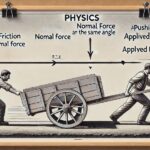Welcome to Physics Heaven, your ultimate destination for mastering physics concepts. In this article, we will explore the topic of “ray optics class 12 notes” in depth. Ray optics, a crucial segment of Class 12 Physics, focuses on the behavior of light in its simplest form: rays. It forms the basis for understanding a variety of optical phenomena and instruments.
Whether you are preparing for your board exams, competitive exams, or just want to gain a solid grasp of the subject, this detailed guide will be your one-stop resource.
What is Ray Optics?
Ray optics, also known as geometrical optics, is a branch of physics that deals with the propagation of light as rays. This simplified approach helps in understanding the laws of reflection, refraction, and the functioning of optical devices like lenses and mirrors. Unlike wave optics, ray optics ignores the wave nature of light, focusing solely on its straight-line propagation.
In Class 12, ray optics forms a vital part of the curriculum under the broader topic of optics, and it plays a significant role in both theoretical and practical physics.
Important Concepts in Ray Optics Class 12 Notes
To master “ray optics class 12 notes,” students should focus on these core concepts:
1. Reflection of Light
Reflection occurs when a light ray strikes a smooth surface and bounces back into the same medium. The two main laws of reflection are:
- The angle of incidence is equal to the angle of reflection.
- The incident ray, reflected ray, and normal to the surface all lie in the same plane.
Reflection is categorized into two types:
- Regular Reflection: Occurs on smooth surfaces like mirrors.
- Diffuse Reflection: Happens on rough surfaces where light scatters in different directions.
2. Refraction of Light
Refraction refers to the bending of light as it passes from one medium to another with a different refractive index. The amount of bending depends on the refractive indices of the two media and the angle of incidence. Key concepts include:
- Snell’s Law: , where and are refractive indices of the two media.
- Critical Angle and Total Internal Reflection: When light travels from a denser to a rarer medium, and the angle of incidence exceeds the critical angle, total internal reflection occurs. This phenomenon is crucial in optical fibers and prisms.
3. Mirrors and Images
Mirrors are devices that reflect light to form images. “Ray optics class 12 notes” covers two main types of mirrors:
- Plane Mirrors: Form virtual, upright, and same-sized images.
- Spherical Mirrors: Can be concave or convex, forming images depending on the object’s position relative to the mirror’s focus and center of curvature.
Important equations include the mirror formula: where is the focal length, is the image distance, and is the object distance.
4. Lenses and Their Applications
Lenses are optical devices that refract light to converge or diverge rays. The two main types are:
- Convex Lenses: Converge light rays and can form real or virtual images depending on object placement.
- Concave Lenses: Diverge light rays and always form virtual images.
The lens formula is similar to the mirror formula:
5. Optical Instruments
Ray optics plays a crucial role in understanding the functioning of optical instruments, such as:
- Microscopes: Used to view small objects with high magnification.
- Telescopes: Designed for observing distant objects like stars and planets.
- Cameras: Use lenses to focus light and form images on a film or sensor.
6. Dispersion and Prism
Dispersion occurs when white light splits into its constituent colors upon passing through a prism. This phenomenon is due to the different refractive indices for various wavelengths of light. “Ray optics class 12 notes” also discusses the concept of angular dispersion and the formation of the spectrum.
7. Power of a Lens
The power of a lens (measured in diopters) indicates its ability to converge or diverge light. It is given by the formula: where is the focal length in centimeters.
Key Diagrams in Ray Optics
Understanding ray diagrams is essential for mastering “ray optics class 12 notes.” Some important diagrams include:
- Reflection and Refraction at Plane Surfaces
- Image Formation by Spherical Mirrors
- Ray Diagrams for Lenses
- Dispersion of Light by a Prism
These diagrams are often asked in exams and provide a visual understanding of the concepts.
Applications of Ray Optics
The principles covered in “ray optics class 12 notes” have a wide range of practical applications, such as:
- Optical Fibers: Used in telecommunications and medical endoscopy.
- Mirrors and Lenses: Integral to devices like cameras, microscopes, and telescopes.
- Spectrometers: Used to analyze the spectrum of light.
- Corrective Eyewear: Based on lens power and optical principles.
Tips for Studying Ray Optics Class 12 Notes
To excel in this topic, follow these tips:
- Understand the Basics: Grasp fundamental laws like reflection, refraction, and Snell’s law.
- Practice Ray Diagrams: Draw and analyze various ray diagrams to visualize light behavior.
- Solve Numerical Problems: Focus on problems related to mirror and lens formulas, critical angle, and total internal reflection.
- Revise Regularly: Use concise “ray optics class 12 notes” for quick revision.
- Refer to Physics Heaven: Our platform provides well-structured notes and practice materials.
Conclusion
Ray optics is a fascinating and essential part of the Class 12 Physics curriculum. By mastering the concepts and equations outlined in these “ray optics class 12 notes,” you can gain a deep understanding of light and its behavior. From reflection and refraction to optical instruments and dispersion, ray optics lays the groundwork for advanced studies and real-world applications.
At Physics Heaven, we aim to simplify complex physics topics for students. Keep practicing, stay curious, and shine bright in your physics journey!








